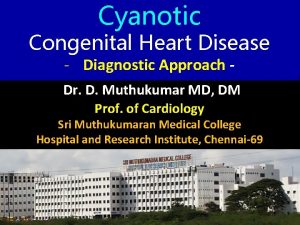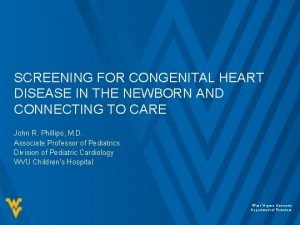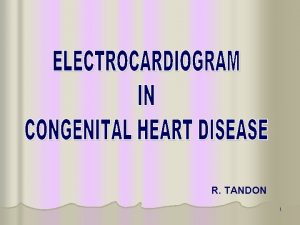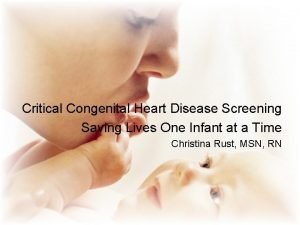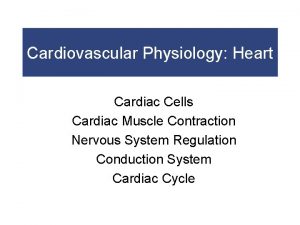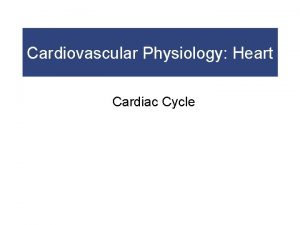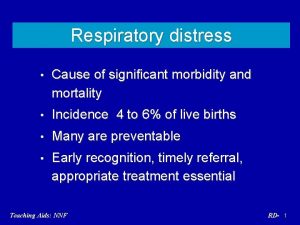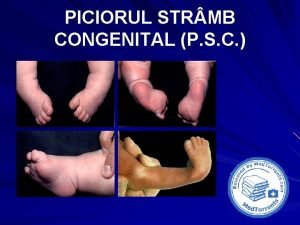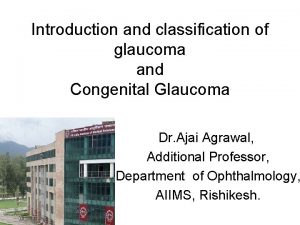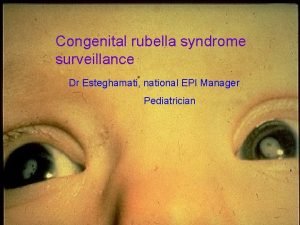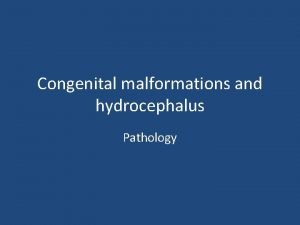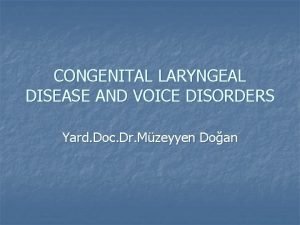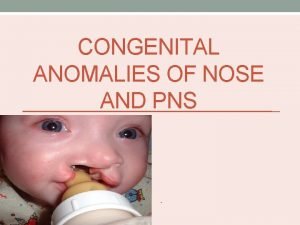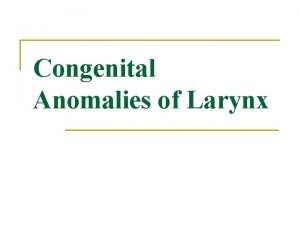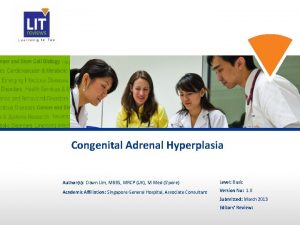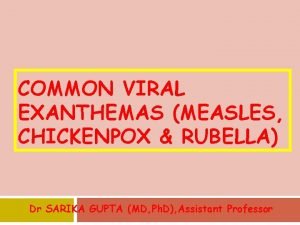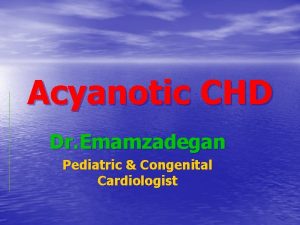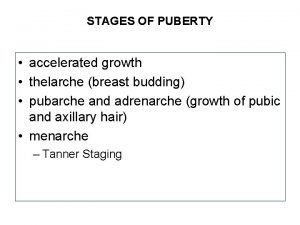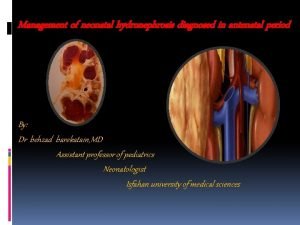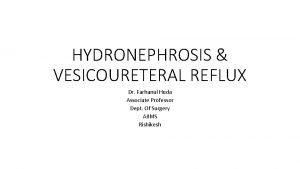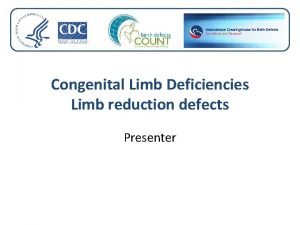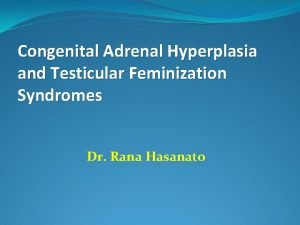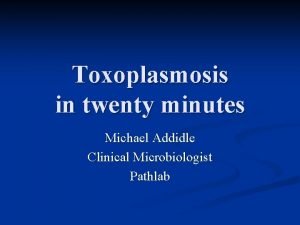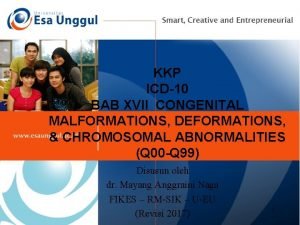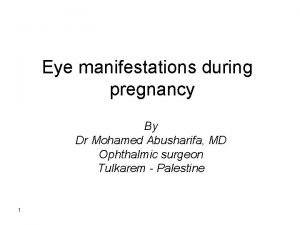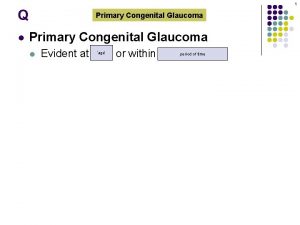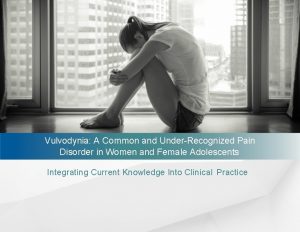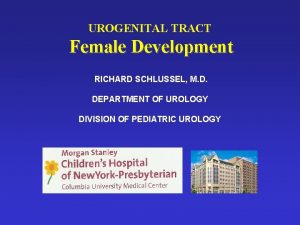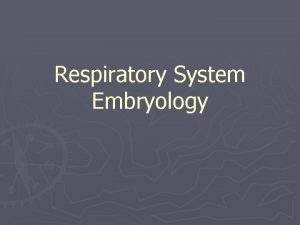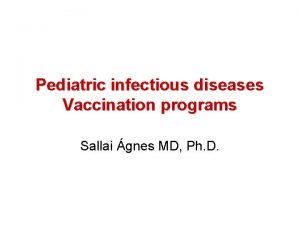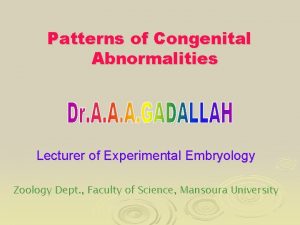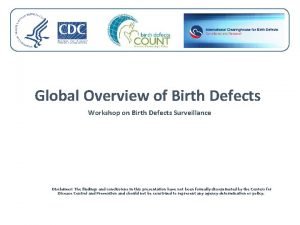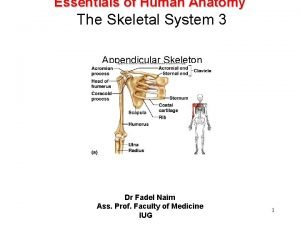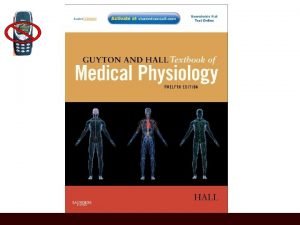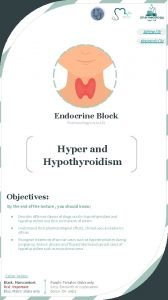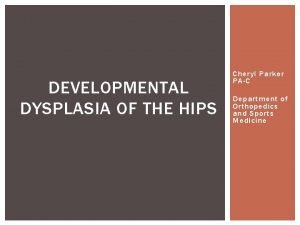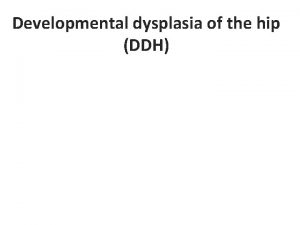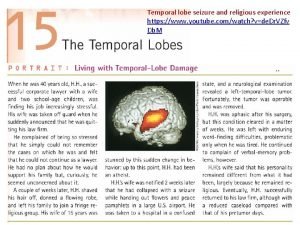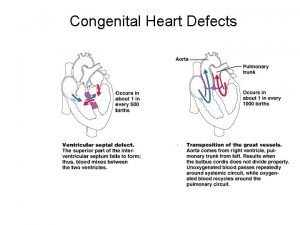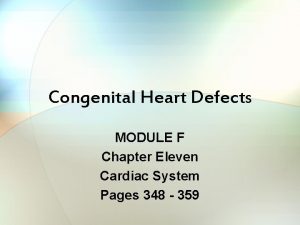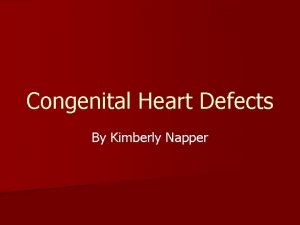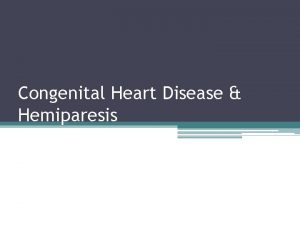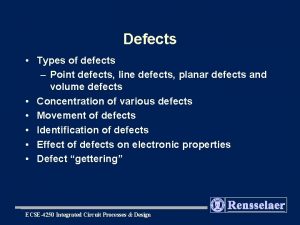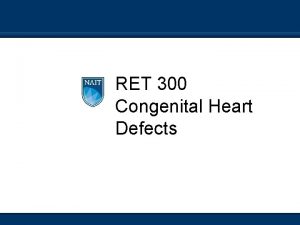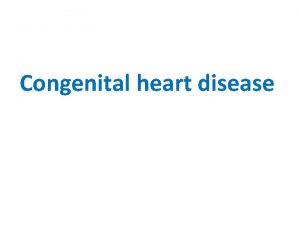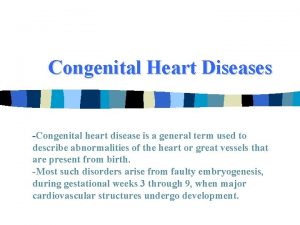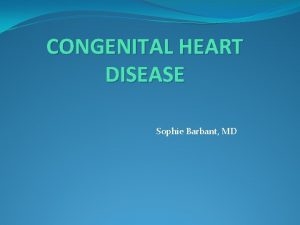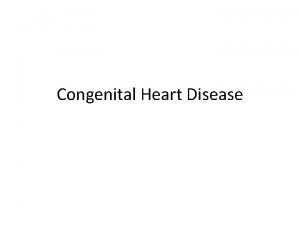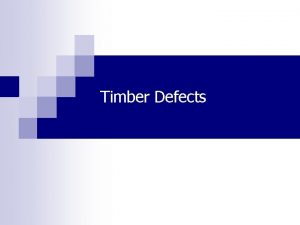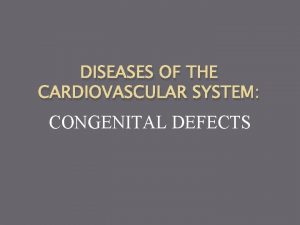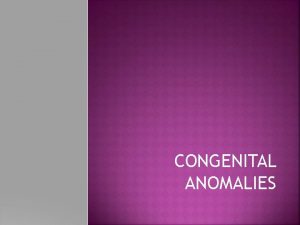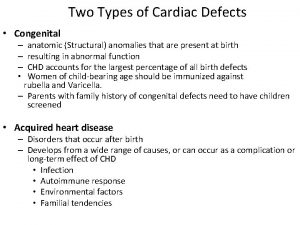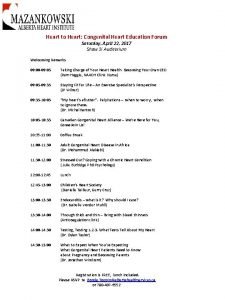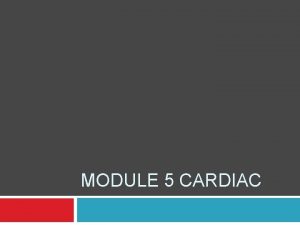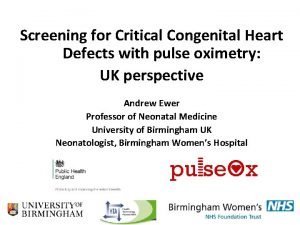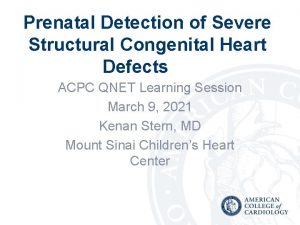Congenital Heart Defects MODULE F Chapter Eleven Cardiac
















































- Slides: 48

Congenital Heart Defects MODULE F Chapter Eleven Cardiac System Pages 348 - 359

Objectives • Differentiate between the different congenital heart diseases and state whether they are cyanotic and acyanotic. • Describe the defect present with each congenital heart disease. • Describe the surgical repair (if any) for each congenital heart disease.

Cardiac Defects • • • Patent Ductus Arteriosus Atrial Septal Defect Ventricular Septal Defect Tetralogy of Fallot Transposition of the Great Arteries Coarctation of the Aorta Anomalous Venous Return Truncus Arteriosus Hypoplastic Left-Heart Syndrome

Web Sites • http: //www. childrensheartinstitute. org/edu cate/defects. htm

Normal Cardiac Blood Flow

Ductus Arteriosus • Fetal Circulation Component • Connects Pulmonary Artery to Aorta • Shunts blood away from lungs • Maintained patent by presence of prostaglandins • Closure secondary to: • Increase in Pa. O 2_ • Decrease in level of prostaglandins

Patent Ductus Arteriosus • 5 -10% of all births (1 of 2000 live births) • 80% of premature babies • 2 -3 times more common in females than males. • 5 th or 6 th most common congenital cardiac defect. • Often associated with other defects. • May be desirable with some defects. • Morbidity/Mortality related to degree of blood flow through PDA.


Pathophysiology - PDA • With a drop in pulmonary arterial pressure (reduction in hypoxic pulmonary vascular constriction), blood will flow through PDA. • LEFT TO RIGHT SHUNT • Increased pulmonary blood flow may lead to pulmonary edema. • Reduced blood flow to all postductal organs • NEC • If pulmonary artery pressure rises above Aortic pressure, blood will move in the other direction. • RIGHT TO LEFT SHUNT

Diagnosis - PDA • Loud grade I to grade III systolic murmur at left sternal border. • Washing machine • Echocardiography

Treatment - PDA • • Restrict fluids. Diuretics Prostaglandin Inhibitors - Indomethacin Surgical closure (ligation).

Atrial Septal Defect • 6 -10% of all births (1 of 1500 live births) • 2 times more common in females than males. • Types: • Ostium Secundum (at or about the Foramen Ovale) • Sinus Venous (at about the point where SVC and IVC attach to Right Atrium) • In 1950 most children with ASD did not reach the first grade. Today, first year surgery facilitates normal growth and development.



ASD: Pathophysiology and Diagnosis • Pathophysiology • Left to Right Shunt • Inefficient recirculation of good blood through pulmonary arteries. • May not manifest symptoms and may be found later in life. • If defect is significant, may cause problems later in life due to inefficiencies. • Diagnosis • Murmur • Echocardiography

Treatment - ASD • Surgical closure. • Non-Surgical closure via cardiac catheterization.

Ventricular Septal Defect • 1% of all births (2 to 4 of 1000 live births) • Vast majority the hole is small. • In 1950, fatal. Today almost all VSD can be closed successfully, even in small babies. Lillehei was the first person in history to correct both ASD and VSD on 8/31/54.



VSD: Pathophysiology & Diagnosis • Pathophysiology • May be isolated or associated with other congenital cardiac defects. • With normal PVR: • LEFT TO RIGHT SHUNT • With elevated PVR (RDS): • RIGHT TO LEFT SHUNT • Diagnosis • Echocardiography

Treatment - VSD • Nothing if VSD is small. • With CHF or Failure to Thrive: Surgical closure. http: //64. 143. 41. 32/news. html

Tetralogy of Fallot • 1% of neonates. • Most common of the cyanotic cardiac diseases. • Mortality increases with age (1 year-old has a 25% mortality, 40 year-old has 95%). • In 1950, fatal. Today, less than 5% mortality with children operated on in infancy, leading normal lives. Four Defects • Pulmonary Artery Stenosis (determinant factor related to severity) • VSD (usually large) • Overriding Aorta • RV hypertrophy



Tetralogy of Fallot: Diagnosis and Treatment • • Tet Spells CXR: Boot-shaped Heart Diagnosed with echocardiography. Surgical correction. • Reparative or Palliative (Blalock-Taussig)


Blalock-Taussig • Something the Lord Made. • Vivien Thomas

Complete Transposition of the Great Arteries • Second most common form (5 -7%) of congenital cardiac anomalies. • Aorta arises from RV and Pulmonary Arteries from LV. • Without an abnormality, life would not be possible. • ASD • VSD (30 -40%) • PDA



Transposition – Diagnosis and Treatment • Diagnosis • Chest X-Ray: “Egg on a String” • Echocardiography • Cardiac Catheterization (? ) • Treatment • Balloon septostomy during cardiac cath. • Rashkind’s Procedure • Reestablish Foramen Ovale • Prostaglandin E 1 to keep PDA open. • Surgical Correction • Jantene Operation


Coarctation of the Aorta • 7% of congenital cardiac defects. • Constriction of the aorta. • Results in severely reduced blood flow. • Increased work on the heart leading to CHF and cardiovascular collapse. • Location of narrowing determines the clinical signs. • Usually associated with PDA, VSD and a defective aortic valve.


Location of Coarctation • Pre-Ductal • Less common but more serious • Associated with VSD, PDA, Transposition • Post-Ductal • More common • Often associated with collateral circulation beyond coarctation, which minimizes effect. • Diagnosed by a difference in blood pressure between lower extremities and upper ones. • Pressure in upper extremities > lower

Coarctation – Diagnosis and Treatment • Diagnosis • Chest X-Ray • Echocardiography • Cardiac catheterization • Treatment • Support with inotropic agents (Dopamine). • Prostaglandins to maintain PDA. • Surgical repair


Anomalous Venous Return • Return of pulmonary venous blood to the right atrium instead of the left. • ASD is present to sustain life. • Can also be partial. • Cyanosis usually present. • Diagnosed with echocardiography. • Surgical correction with reimplantation of pulmonary veins.


Truncus Arteriosus • Defect in which one large vessel arises from right and left heart over a large VSD. • Cyanosis is often present. • CHF common. • Diagnosed with echocardiography and cardiac catheterization. • Surgery: • Separate pulmonary arteries from truncus. • Closure of VSD • Create valved connection between RV and Pulmonary Artery


Repair of Truncus Arteriosus

Hypoplastic Left-Heart Syndrome • Several anomalies: • Coarctation of the aorta • Hypoplastic left ventricle • Aortic and mitral valve stenosis or atresia. • Cyanotic defect. • Right heart pumps blood to body through PDA. • Closure of PDA results in hypotension, shock, and death. • Maintain hypoxemia with normalized CO 2 levels. • “ 40 -40 Club”

1 Patent foramen ovale 2 Coarctation of the aorta 3 Patent ductus arteriosus 4 Narrowed aorta 5 Hypoplastic left ventricle 6 Aortic atresia

Surgical Treatment of Hypoplastic Left Heart Syndrome • Three separate surgeries. • Norwood procedure • First few days after birth. • Glenn Shunt (Cavo Pulmonary Connection) • 3 -9 months of age • Fontan Procedure • 2 years of age • Less wait because of damage from pulmonary hypertension.

Stage I - Norwood Procedure

Stage II - Glenn Shunt

Stage III – Fontan Procedure
 Eisenmenger syndrome
Eisenmenger syndrome Asd vs pulmonary stenosis murmur
Asd vs pulmonary stenosis murmur Tga cxr
Tga cxr Canadian congenital heart alliance
Canadian congenital heart alliance Farah garmany
Farah garmany Congenital heart
Congenital heart Congenital heart defect
Congenital heart defect Module eleven lesson one self check quiz
Module eleven lesson one self check quiz Refractory period cardiac
Refractory period cardiac Heart sounds and murmurs
Heart sounds and murmurs C device module module 1
C device module module 1 кагами-огата
кагами-огата Congenital pneumonia
Congenital pneumonia Picior stramb congenital
Picior stramb congenital Stumped cornea
Stumped cornea Congenital rubella syndrome
Congenital rubella syndrome Congenital malformations
Congenital malformations Congenital voice disorders
Congenital voice disorders Congenital hypothyroidism
Congenital hypothyroidism Congenital fibrosis of the extraocular muscles
Congenital fibrosis of the extraocular muscles Polyrhinia
Polyrhinia Congenial
Congenial Congenital adrenal hyperplasia electrolytes
Congenital adrenal hyperplasia electrolytes Congenital rubella syndrome triad
Congenital rubella syndrome triad Endocardial cushion defect
Endocardial cushion defect Congenital rubella syndrome triad
Congenital rubella syndrome triad Congenital adrenal hyperplasia characteristics
Congenital adrenal hyperplasia characteristics Potter face oligohydramnios
Potter face oligohydramnios Congenital hydronephrosis
Congenital hydronephrosis Defect
Defect Virilisation in females
Virilisation in females Michael addidle
Michael addidle Cyptorchism
Cyptorchism Congenital toxoplasmosis
Congenital toxoplasmosis Congenital anomaly
Congenital anomaly Congenital glaucoma triad
Congenital glaucoma triad Congenital neuroproliferative vestibulodynia
Congenital neuroproliferative vestibulodynia Schlussel urology
Schlussel urology Congenital diaphragmatic hernia
Congenital diaphragmatic hernia Congenital rubella
Congenital rubella Causes of congenital anomalies
Causes of congenital anomalies Spina bifida
Spina bifida Greater and lesser pelvis
Greater and lesser pelvis Congenital adrenal hyperplasia
Congenital adrenal hyperplasia Antithyroid drugs mnemonic
Antithyroid drugs mnemonic Barlow sign
Barlow sign Von rosen line ddh
Von rosen line ddh Puberty disorder
Puberty disorder Congenital amusia
Congenital amusia
